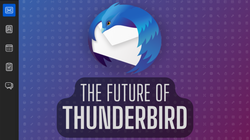Mozilla Thunderbird: Why We’re Rebuilding The Thunderbird Interface From Scratch
Thunderbird is quickly approaching its 20th anniversary as a standalone email client. And as we get closer to this year’s release of Thunderbird 115 “Supernova” we’re hearing a certain question more and more often:
“Why does Thunderbird look so old, and why does it take so long to change?”
~ A notable percentage of Thunderbird users
It’s certainly a valid one, so let’s spend some time answering it!
As Thunderbird’s Product Design manager, I have some good insights into what’s happening and where things are going. Consider this article (and the companion video below) the first painting in a more complete mural showing where Thunderbird is headed, and why some of the things we’re doing might seem counterintuitive.
Some of the talking points below might be divisive. They might touch a nerve. But we believe in being transparent and open about both our past and our future.
[...]
Thunderbird is literally a bunch of code running on top of Firefox. All the tabs and sections you see in our applications are just browser tabs with a custom user interface.
We love using Firefox as our base architecture, because it leverages all the very good stuff within. Things like cross-platform support, the Gecko web renderer, the Spidermonkey JavaScript compiler, and so on.
[...]
That cost — and what I’ll talk about next — is why Thunderbird has accumulated an enormous amount of “technical debt” to pay off.
Throughout the years, Mozilla’s focus shifted a lot, investing less and less resources into the development of Thunderbird. On July 6, 2012, the Mozilla Foundation announced that it would no longer be focused on innovations for Thunderbird, and that the future Thunderbird development would transition to a community-driven model.
This meant that community members and external contributors would be in charge of developing and supporting Thunderbird.

